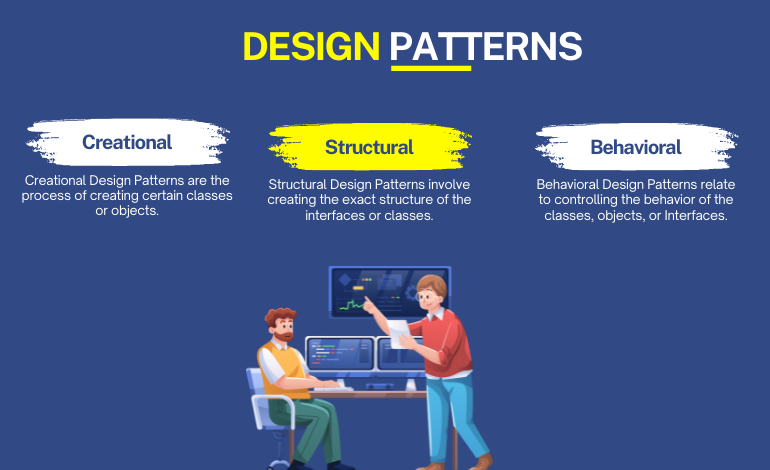In software engineering, design patterns represent proven solutions to common problems that occur during software design. These patterns provide templates and best practices that can help developers write more efficient, maintainable, and scalable code. Understanding design patterns is key to building robust software systems as they encourage modularity, reusability, and adherence to solid design principles. This blog post will explore the concept of design patterns, their types, and why they are important in software engineering.
What are Design Patterns?
A design pattern is a reusable solution to a recurring problem in software design. It’s not a piece of code or a library but a general guideline or template that can be applied to solve specific design problems. Design patterns are not language-specific and can be used in any object-oriented programming environment.
They fall into three main categories:
- Creational Patterns: Deal with object creation mechanisms, trying to create objects in a way suitable for the situation.
- Structural Patterns: Focus on how classes and objects are composed to form larger structures.
- Behavioral Patterns: Deal with communication between objects and classes, focusing on how objects interact and distribute responsibilities.
Types of Design Patterns
1. Creational Design Patterns
Creational patterns provide ways to instantiate objects, hiding the complexity of creating instances and making the system independent of how its objects are created. The most popular creational patterns include:
- Singleton Pattern: Ensures that a class has only one instance and provides a global point of access to it.
- Factory Pattern: Provides an interface for creating objects, allowing subclasses to alter the type of objects that will be created.
- Abstract Factory Pattern: Allows for the creation of families of related or dependent objects without specifying their concrete classes.
- Builder Pattern: Separates the construction of a complex object from its representation so that the same construction process can create different representations.
- Prototype Pattern: Allows for creating new objects by copying an existing object, known as a prototype.
2. Structural Design Patterns
Structural patterns focus on composing classes and objects into larger structures while keeping these structures flexible and efficient. Common structural patterns include:
- Adapter Pattern: Allows incompatible interfaces to work together by wrapping an object with a compatible interface.
- Bridge Pattern: Separates an object’s abstraction from its implementation so that both can vary independently.
- Composite Pattern: Composes objects into tree-like structures to represent part-whole hierarchies, allowing individual objects and compositions to be treated uniformly.
- Decorator Pattern: Adds additional functionality to objects dynamically without modifying their structure.
- Facade Pattern: Provides a simplified interface to a complex subsystem, making it easier to interact with.
- Flyweight Pattern: Reduces the cost of creating a large number of similar objects by sharing as much data as possible.
- Proxy Pattern: Provides a placeholder for another object to control access, reduce cost, or enhance functionality.
3. Behavioral Design Patterns
Behavioral patterns focus on the interaction and responsibility of objects. They help in better communication and responsibilities between objects. Some of the key behavioral patterns are:
- Chain of Responsibility Pattern: Passes requests along a chain of handlers, where each handler either processes the request or passes it on to the next handler.
- Command Pattern: Encapsulates a request as an object, allowing parameterization of clients with queues, requests, and operations.
- Observer Pattern: Defines a one-to-many dependency between objects where one object changes state, all its dependents are notified and updated automatically.
- Strategy Pattern: Allows a family of algorithms to be defined and made interchangeable within that family.
- State Pattern: Allows an object to alter its behavior when its internal state changes.
- Template Method Pattern: Defines the skeleton of an algorithm but allows subclasses to modify specific steps without changing the algorithm’s structure.
- Visitor Pattern: Allows you to define new operations on a class without changing the class by passing operations through an object structure.
Why Are Design Patterns Important?
- Reusability: By using design patterns, developers can avoid writing redundant code by using proven solutions to common problems. This makes the code more reusable and efficient.
- Maintainability: Since design patterns provide a clear structure to the code, maintaining and updating the codebase becomes easier. Patterns encourage writing modular code, where different parts of the system can be updated without affecting others.
- Modularity: Design patterns promote modularity, where software components are self-contained and can be easily swapped or replaced without impacting the entire system.
- Efficiency: By applying design patterns, developers can create more optimized code, making the software efficient in terms of performance and memory usage.
- Common Language: Design patterns provide a shared vocabulary for developers, making communication easier. Using common pattern names (like Singleton, Observer, etc.) helps teams to quickly understand the design intent.
- Solving Complex Problems: Many patterns are designed to address complex design issues, such as managing object creation, handling communication between objects, or maintaining flexibility in code structure.
Practical Examples of Design Patterns
- Singleton Pattern: A typical use of the Singleton pattern is a class that manages database connections in an application. By using the Singleton, you can ensure that only one instance of the connection exists throughout the application.
- Factory Pattern: A car manufacturing system might use a Factory pattern to create different types of cars (SUVs, sedans, trucks) without needing to modify the client code that requests the car creation.
- Observer Pattern: In a stock market application, the Observer pattern could be used to notify all subscribers (observers) whenever the stock prices (subject) change.
- Decorator Pattern: A coffee shop application might use the Decorator pattern to dynamically add toppings or extras (like milk, sugar) to a coffee order without changing the coffee object’s structure.
Conclusion
Design patterns provide a blueprint for solving common software design problems in a flexible, efficient, and maintainable way. They allow developers to build robust, scalable applications by promoting reusable, modular, and efficient code. Mastering design patterns is essential for any software engineer looking to build quality software and is especially important when working in teams to ensure clear communication and maintainability.
At TechsterTech, we help organizations implement the right design patterns to build scalable, high-performing software systems. Contact us to learn more about how we can support your software development projects.



